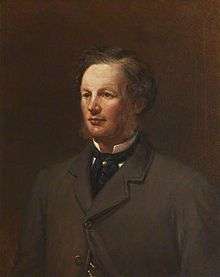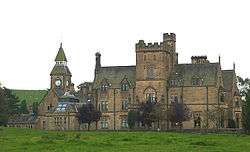William Henry Wakefield
William Henry Wakefield (1828–1889) was an English banker.

Life
He belonged the Kendal banking family of Wakefield, being the son of John Wakefield III.[1] The Wakefields were Quakers, but his father had been disowned by the Kendal Society of Friends on marrying an Anglican.[2] He was born at Broughton Lodge near Cartmel, on 18 May 1828, one of six children of John Wakefield and Fanny McArthur of Glasgow.[3][4]
Wakefield was a partner in Wakefield Crewdson & Co., the family bank to which his father brought him in, during 1850; and a gunpowder manufacturer.[1][5] In 1863 the Wakefield family took on a majority share of the bank; in 1864 Wakefield became the senior partner.[6]
Wakefield was a director of the South Durham and Lancashire Union Railway, a cross-Pennine venture to connect Furness to the north-east in which Kendal men were well represented.[7][8] He was also a landowner, with over 5000 acres in Westmorland in 1873.[9]
In 1858 Wakefield built a house at Prizett, 2.5 miles south of Kendal.[10][11] After his father's death in 1866, he had a 7/16 share of the bank, and set about building Sedgwick House, nearby.[12][13] It replaced the old house of the same name, just to the north-west on the same site.[14] He also supported the building of St Thomas' Church, Crosscrake, which used the same architects, Paley and Austin, as Sedgwick House.[15] With Sir Francis Powell he succeeding in turning round Sedbergh School, when it was close to collapse.[16]

Wakefield died while hunting.[17] The gunpowder company W. H. Wakefield & Co. continued into the 20th century.[18] The Kendal bank was bought by the Bank of Liverpool in 1893.[19]
Family
He married Augusta, daughter of James Hagarty, US Consul at Liverpool.[3] Their children, four sons and three daughters, included Mary Wakefield (1853–1910), organiser of music festivals.[4][12][20]
References
- George Chandler (1968). Four Centuries of Banking. 2. B. T. Batsford.
Notes
- 1 2 Chandler, p. 99.
- ↑ Rosemary Mingins (2004). The Beacon Controversy and Challenges to British Quaker Tradition in the Early Nineteenth Century. Edwin Mellen Press. p. 241. ISBN 0-7734-6383-6.
- 1 2 https://archive.org/stream/marywakefieldmem00newmuoft#page/12/mode/2up
- 1 2 Joseph Foster, The descendants of John Backhouse, yeoman, of Moss Side, near Yealand Redman, Lancashire vol. 1 (1894), p. 71–3; archive.org.
- ↑ A directory of the joint-stock and private banks in England and Wales. 1852. p. vi. Retrieved 23 April 2013.
- ↑ Chandler, p. 100.
- ↑ Maurice W. Kirby (4 July 2002). The Origins of Railway Enterprise: The Stockton and Darlington Railway 1821-1863. Cambridge University Press. p. 188. ISBN 978-0-521-89280-3. Retrieved 23 April 2013.
- ↑ Margaret E. Shepherd (2003). From Hellgill To Bridge End: Aspects of Economic and Social Change in the Upper Eden Valley Circa 1840-95. Univ of Hertfordshire Press. p. 200. ISBN 978-1-902806-32-7. Retrieved 23 April 2013.
- ↑ John Duncan Marshall; John K. Walton (1981). The Lake Counties from 1830 to the Mid-twentieth Century: A Study in Regional Change. Manchester University Press. p. 122. ISBN 978-0-7190-0824-5. Retrieved 23 April 2013.
- ↑ https://archive.org/stream/marywakefieldmem00newmuoft#page/14/mode/2up
- ↑ Black Adam and Charles, ltd; John Phillips (1870). Black's picturesque guide to the English lakes. p. 11. Retrieved 23 April 2013.
- 1 2 Chandler, p. 101.
- ↑ https://archive.org/stream/marywakefieldmem00newmuoft#page/16/mode/2up
- ↑ Historic England. "Sedgwick House (503308)". PastScape. Retrieved 8 October 2015.
- ↑ The Story of St Thomas Crosscrake.
- ↑ Frederic Blagden Malim (1948). Almae Matres: Recollections of Some Schools at Home and Abroad. CUP Archive. p. 33. GGKEY:PQ8ZGX74UXE. Retrieved 23 April 2013.
- ↑ Howard L. Malchow (1992). Gentlemen Capitalists: The Social and Political World of the Victorian Businessmen. Stanford University Press. p. 223. ISBN 978-0-8047-1807-3. Retrieved 23 April 2013.
- ↑ https://archive.org/stream/riseprogressofbr00interich#page/414/mode/2up
- ↑ Chandler, vol. 1, p. 379.
- ↑ http://www.mwwf.co.uk/history-of-the-festival/page_2.html